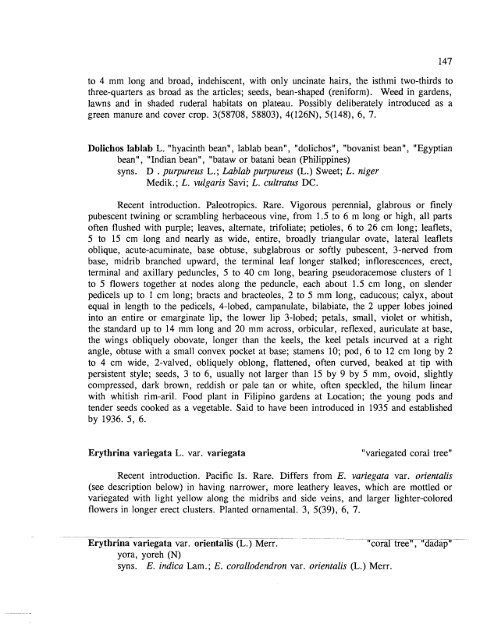atoll research bulletin no. 392 the flora of - Smithsonian Institution ...
atoll research bulletin no. 392 the flora of - Smithsonian Institution ...
atoll research bulletin no. 392 the flora of - Smithsonian Institution ...
You also want an ePaper? Increase the reach of your titles
YUMPU automatically turns print PDFs into web optimized ePapers that Google loves.
to 4 mm long and broad, indehiscent, with only uncinate hairs, <strong>the</strong> isthmi two-thirds to<br />
three-quarters as broad as <strong>the</strong> articles; seeds, bean-shaped (reniform). Weed in gardens,<br />
lawns and in shaded ruderal habitats on plateau. Possibly deliberately introduced as a<br />
green manure and cover crop. 3(58708, 58803), 4(126N), 5(148), 6, 7.<br />
Dolichos lablab L. "hyacinth bean", lablab bean", "dolichos", "bovanist bean", "Egyptian<br />
bean", "Indian bean", "bataw or batani bean (Philippines)<br />
syns. D . purpureus L.; Lablab purpureus (L.) Sweet; L. niger<br />
Medik. ; L. vulgaris Savi; L. cultratus DC.<br />
Recent introduction. Paleotropics. Rare. Vigorous perennial, glabrous or finely<br />
pubescent twining or scrambling herbaceous vine, from 1.5 to 6 m long or high, all parts<br />
<strong>of</strong>ten flushed with purple; leaves, alternate, trifoliate; petioles, 6 to 26 cm long; leaflets,<br />
5 to 15 cm long and nearly as wide, entire, broadly triangular ovate, lateral leaflets<br />
oblique, acute-acuminate, base obtuse, subglabrous or s<strong>of</strong>tly ,pubescent, 3-nerved from<br />
base, midrib branched upward, <strong>the</strong> terminal leaf longer stalked; inflorescences, erect,<br />
terminal and axillary peduncles, 5 to 40 cm long, bearing pseudoracemose clusters <strong>of</strong> 1<br />
to 5 flowers toge<strong>the</strong>r at <strong>no</strong>des along <strong>the</strong> peduncle, each about 1.5 cm long, on slender<br />
pedicels up to 1 cm long; bracts and bracteoles, 2 to 5 mm long, caducous; calyx, about<br />
equal in length to <strong>the</strong> pedicels, 4-lobed, campanulate, bilabiate, <strong>the</strong> 2 upper lobes joined<br />
into an entire or emarginate lip, <strong>the</strong> lower lip 3-lobed; petals, small, violet or whitish,<br />
<strong>the</strong> standard up to 14 mm long and 20 mm across, orbicular, reflexed, auriculate at base,<br />
<strong>the</strong> wings obliquely obovate, longer than <strong>the</strong> keels, <strong>the</strong> keel petals incurved at a right<br />
angle, obtuse with a small convex pocket at base; stamens 10; pod, 6 to 12 cm long by 2<br />
to 4 cm wide, 2-valved, obliquely oblong, flattened, <strong>of</strong>ten curved, beaked at tip with<br />
persistent style; seeds, 3 to 6, usually <strong>no</strong>t larger than 15 by 9 by 5 mm, ovoid, slightly<br />
compressed, dark brown, reddish or pale tan or white, <strong>of</strong>ten speckled, <strong>the</strong> hilum linear<br />
with whitish rim-aril. Food plant in Filipi<strong>no</strong> gardens at Location; <strong>the</strong> young pods and<br />
tender seeds cooked as a vegetable. Said to have been introduced in 1935 and established<br />
by 1936. 5, 6.<br />
Erythrina variegata L. var. variegata "variegated' coral tree"<br />
Recent introduction. Pacific Is. Rare. Differs from E. variegata var. orientalis<br />
(see description below) in having narrower, more lea<strong>the</strong>ry leaves, which are mottled or<br />
variegated with light yellow along <strong>the</strong> midribs and side veins, and larger lighter-colored<br />
flowers in longer erect clusters. Planted ornamental. 3, 5(39), 6, 7.<br />
-- - - _. -<br />
Erythrina variegata var. orientalis (L.) Merr. "coral tree",<br />
yora, yoreh (N)<br />
syns. E. inllica Lam. ; E. corallodendron var. orientalis (L.) Merr.

















